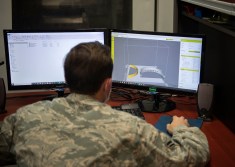DOD: 3-D printers may have a place on the battlefield
A new 3-D printer capable of producing integrated circuits and other electronic parts might one day alleviate the need for physical supply routes for the U.S. military by enabling troops to print out spare parts for their equipment, or even whole weapons systems, on the battlefield itself.
In a post on “Armed With Science,” the DOD’s official science blog, the Pentagon released the details of MultiFab, a 3-D printing device with “limitless” possibilities that was designed by researchers at the Massachusetts Institute of Technology’s Computer Science and Artificial Intelligence Laboratory.
With a price tag of only $7,000 per unit, MultiFab boasts the capacity to carry and use 10 materials simultaneously. Similar platforms routinely span into the six-figure price range and lack the standard precision options that MultiFab offers.
“Before a warfighter can print a missile in the field, you need quality, controlled processes to fabricate all the component materials: the metallic strongbacks, and the plastic connectors, the semiconductors for processors, and the energetics and propulsion systems,” the post quotes Chris McCarroll, the director of the National Additive Manufacturing Innovation Institute. “The hard part is then making the connections between these components, as an example, the integrated control circuit that receives the command to light the fuse.”
MultiFab eliminates the need for separate assemblage of sensitive parts with its embedding feature, which includes the printing of small, complex technical components like chips and circuits within the overall frame of the device as it is printed. With MultiFab, the final product is constructed all at once.
Successful, wide-scale deployment of MultiFab devices could drastically reduce the need for shipping supplies, as engineers on the battlefield would only need 3-D files to construct even advanced electronics. According to the blog, replacing the physical supply chain with a digital one would “save the Department of Defense both time and money,” because “[d]igital supply chains are more agile, secure and improve operational readiness.”
“The potential impact in scaling advances manufacturing across the defense enterprise cannot be overstated,” McCarroll said.






